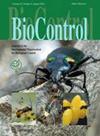用食线虫真菌衣孢球孢菌对覆盖作物白莲根结线虫的生物强化防治
IF 2.7
2区 农林科学
Q1 ENTOMOLOGY
引用次数: 0
摘要
根结线虫在全球范围内造成广泛的经济损失。研究了用食线虫真菌Pochonia chlamydosporia (Hypocreales: Clavicipitaceae)接种覆膜作物pacelia tanacetifolia (Boraginaceae)后,其种子包衣保护番茄植株免受根结线虫melidogyne hapla (Tylenchida: meloidogyididididyidae)造成的根系损伤的潜力。因此,用衣孢假单胞菌包被tanacetifolia种子,种植在hapla感染的盆栽中。在侵染土壤中生长50 d后,从tanacetifolia根中提取hapla卵并定量。在剩余土壤中生长的番茄植株可作为hapla侵染的生物指标,用瘿指数表示。结果表明,衣孢假单胞菌包衣(每粒种子290±51 CFU)可使褐皮假单胞菌的卵数减少95.6%。衣孢波chonia chlamydosporia作为胚孢子悬浮液(每600 ml土壤中有5·10 8个胚孢子)可使hapla m.s hapla卵的数量减少75.5%。此外,在先前种植过衣孢假单胞菌的tanacetifolia种子的基质中生长50天的番茄植株的瘿指数明显低于在未处理的盆栽中生长的植株。综上所述,衣孢假单胞菌种子包衣对tanacetifolia的生物增强作用成功地减少了hapla,从而为该线虫的管理提供了一种额外的工具。该方法仍有进一步改进的潜力,如通过优化配方技术提高种子包衣内胚孢子的活力。本文章由计算机程序翻译,如有差异,请以英文原文为准。
Biological enhancement of the cover crop Phacelia tanacetifolia (Boraginaceae) with the nematophagous fungus Pochonia chlamydosporia to control the root-knot nematode Meloidogyne hapla in a succeeding tomato plant
Abstract Root-knot nematodes cause global economic losses in a wide range of crops. We investigated the potential of seed coatings of the cover crop Phacelia tanacetifolia (Boraginaceae) when inoculated with the nematophagous fungus Pochonia chlamydosporia (Hypocreales: Clavicipitaceae) to protect subsequently grown tomato plants from root galling caused by the root-knot nematode Meloidogyne hapla (Tylenchida: Meloidogynidae). Therefore, seeds of P. tanacetifolia were coated with P. chlamydosporia blastospores and planted in M. hapla -infested pots. After 50 days of growth in infested soil, M. hapla eggs were extracted from P. tanacetifolia roots and quantified. Tomato plants grown in the remaining soil served as bioindicator of M. hapla infestation as expressed by the gall index. Results showed that seed coating of P. tanacetifolia with P. chlamydosporia (290 ± 51 CFU per seed) reduced the number of M. hapla eggs up to 95.6% in comparison to untreated controls. Pochonia chlamydosporia as blastospore suspension (5·10 8 blastospores per 600 ml soil) reduced the number of M. hapla eggs by up to 75.5%. Additionally, tomato plants grown for 50 days in substrates previously planted with P. tanacetifolia seeds coated with P. chlamydosporia showed a significantly lower gall index than plants grown in untreated pots. In conclusion, biological enhancement of P. tanacetifolia by seed coating with P. chlamydosporia successfully reduced M. hapla and thus provides an additional tool in the management of this nematode. The method still has potential for further improvement such as increasing blastospore viability within the seed coating by optimized formulation technology.
求助全文
通过发布文献求助,成功后即可免费获取论文全文。
去求助
来源期刊

BioControl
生物-昆虫学
CiteScore
5.00
自引率
4.00%
发文量
42
审稿时长
12 months
期刊介绍:
BioControl, the official journal of the International Organization for Biological Control, presents original papers on basic and applied research in all aspects of biological control of invertebrate, vertebrate and weed pests, and plant diseases. Coverage includes biology and ecology of organisms for biological control, and aspects of use including biological controls for integrated pest management, such as plant resistance, pheromones and intercropping. Papers presenting only laboratory trials on non-target effects of pesticides on natural enemies are not considered but papers dealing with the corresponding effects on community dynamics of natural enemies are welcomed.
Organisms covered include parasitoids, invertebrate and vertebrate predators of pest animals and plants, mites, plant and insect pathogens, nematodes, and weeds.
The journal publishes interdisciplinary papers with a global perspective on the use of biological control in integrated pest management systems, and related developments in molecular biology and biotechnology that have direct relevance.
 求助内容:
求助内容: 应助结果提醒方式:
应助结果提醒方式:


